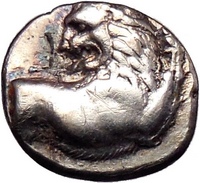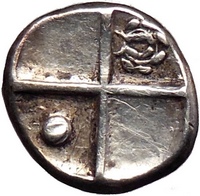Chersonesos in Kardia Thrace Authentic Ancient
Silver Greek Coins for Sale Online
Buy authentic ancient 400 B.C. silver Greek coins of Chersonesos that
feature the lion. Read the history of the city and explore a large
selection of ancient coins from a trusted online ancient coin dealer.
Every coin comes with it's own custom-made, unique certificate of
authenticity $50-$100 value, absolutely free, a lifetime guarantee of
authenticity, professional research photograph and history. The best
value at an online coin shop you will find! You can also explore explore
a selection of thousands of certified authentic ancient Greek, Roman,
Biblical, Byzantine coins, artifacts and beyond at a trusted eBay online
coin shop. A fun way to learn about and preserve history for future
generations. Ancient coins make a great gift, investment and collection
all in one.
 
Example of Authentic Ancient
Coin of:
Greek city of Chersonesos (possibly the same
place as the later Kardia) in Thrace
Silver Hemidrachm Struck 400-350 B.C.
Reference: Sear 1602; B.M.C. 3.p.183,8,9
Forepart of lion right, looking back, paws raised.
Quadrapartite incuse square, the alternate depressions deeper.
Chersonesos (Ancient
Greek: ) was an
ancient Greek city located in Thrace ,
located in the region of the
Thracian Chersonesos.
The Thracian Chersonese was the ancient name of the
Gallipoli peninsula, in the part of
historic
Thrace that is now part of modern
Turkey.
The peninsula runs in a south-westerly direction into the
Aegean Sea, between the
Hellespont (now known as the
Dardanelles) and the bay of Melas
(today Saros bay). Near
Agora it was protected by a wall
running across its full breadth. The isthmus traversed by the wall was
only 36
stadia in breadth (about 6.5 km), but
the length of the peninsula from this wall to its southern extremity,
Cape Mastusia, was 420 stadia (about 77.5 km).
History
The Thracian Chersonese was originally inhabited by
Thracians. Settlers from
Ancient Greece, mainly of
Ionian and
Aeolian stock, founded about 12 cities
on the peninsula in the
7th
century BC. The
Athenian statesman
Miltiades the Elder founded a major
Athenian colony there around 560 BC. He took authority over the entire
peninsula, building up its defences against incursions from the
mainland. It eventually passed to his nephew, the more famous
Miltiades the Younger, around 524 BC.
The peninsula was abandoned to the
Persians in 493 BC after the outbreak
of the
Greco-Persian Wars (499478 BC).
The Persians were eventually expelled, after which the peninsula was
for a time ruled over by Athens, which enrolled it into the
Delian League in 478 BC. The Athenians
established a number of
cleruchies on the Thracian Chersonese
and sent an additional 1,000 settlers around 448 BC. Sparta gained
control between 431 BC-404 BC, but the peninsula subsequently reverted
to the Athenians. In the
4th
century BC, the Thracian Chersonese became the focus of a
bitter territorial dispute between Athens and
Macedon, whose king
Philip II sought possession. It was
eventually ceded to Philip in 338 BC.
After the death of Philip's son
Alexander the Great in 323 BC, the
Thracian Chersonese became the object of contention among
Alexander's successors.
Lysimachus established his capital
Lysimachia here. In 196 BC, the
Seleucid king
Antiochus III seized the peninsula.
This alarmed the Greeks and prompted them to seek the aid of the
Romans, who conquered the Thracian
Chersonese, which they gave to their ally
Eumenes II of
Pergamon in 188 BC. At the extinction
of the
Attalid dynasty in 133 BC it passed
again to the Romans, who from 129 BC administered it in the Roman
province of
Asia. It was subsequently made a
state-owned territory (ager publicus) and during the reign of the
emperor
Caesar Augustus it was imperial
property.
The Thracian Chersonese subsequently passed to the
Byzantine Empire, which ruled it until
the rise of the
Ottoman Empire in the 14th century AD.
In 1356 the peninsula became the first part of Europe to fall to the
Ottomans, who subsequently made it a major base for raids and incursions
into territories further afield.
Towns
and economy
The principal towns of the Thracian Chersonese were
Cardia,
Pactya,
Callipolis (Gallipoli),
Alopeconnesus,
Sestos,
Madytus, and
Elaeus. The peninsula was renowned for
its
wheat. It also benefited from its
strategic importance on the main route between
Europe and
Asia, as well as from its control of
the shipping route from
Crimea. The city of Sestos was the main
crossing-point on the Hellespont (Dardanelles).
|